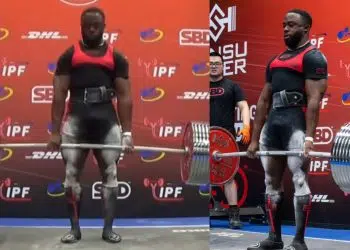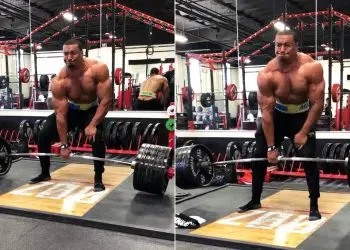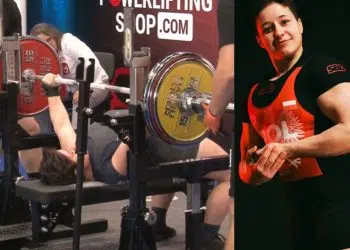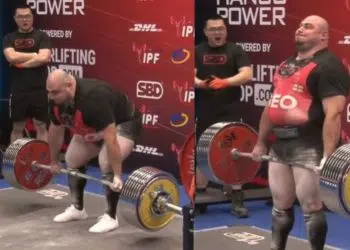Over the last few years, a number of fitness tools have been released into the market that allow resistance trainees and coaches to measure both power and speed components during training. A lot of people are finding that making the switch from percentage-based training to this new velocity-based training (VBT) is leading to better workout results and strength gains.
Below, we’re going to take a deep dive into what exactly velocity-based training is, how you can use it, the science backing it up, and what tools you’ll need. By the end of this article, you’ll be ready to give VBT a try—and see how it changes your workouts significantly!
What is Velocity-Based Training?
Let’s start off by defining velocity-based training.
Simply put, it’s a form of training that measures the speed of movement of a specific load lifted during exercise, rather than just the weight of that load based on the percentage of your 1-Rep Max weight.
VBT originated in the 1980s, and became more widespread during the 1990s. However, it has only been in the last few years that it has really become popular—now that a variety of devices are used to track speed of movement during workout.
Standard percentage-based training typically looks at how much you’re capable of lifting (your 1-Rep Max) and has you lift a certain percentage. For “light” endurance training, perhaps that percentage will be 55-70% of your 1-Rep Max weight. For heavier power training, the percentage may be up to 85 or 90% of the 1-Rep Max weight.
Level Up Your Fitness: Join our 💪 strong community in Fitness Volt Newsletter. Get daily inspiration, expert-backed workouts, nutrition tips, the latest in strength sports, and the support you need to reach your goals. Subscribe for free!
With velocity-based training, however, the percentage of the load matters far less than the speed of movement of your exercise. Your goal is to hit a certain target speed (perhaps 0.4 or 0.7 meters per second), and once you drop below that speed, that’s how you know you’re approaching failure.
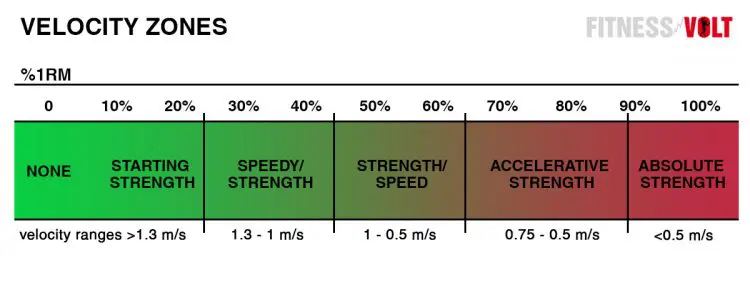
Basically, it comes down to the simple physics formula that governs all movement:
Mass x Acceleration = Force
Most standard training modalities focus on the MASS aspect of the training—ergo, the load, the amount of weight being lifted. This is one way to increase force generation, by constantly increasing the mass being moved.
However, VBT focuses on the other part of the equation, the acceleration, more than the load. The result is still the same—increased force generation—but the approach is different.
Why VBT vs. PBT?
Percentage-based training has been the norm for so many years that a lot of people reading about velocity-based training wonder, “Why should I make the switch? Is VBT better than PBT? Why?”
Constantly-changing capabilities. One of the “drawbacks” of percentage-based training is that it adheres to a more rigid metric of “percentage of 1-Rep Max”. That means that if a trainee’s last 1-Rep Max was 200 kilograms, they’ll be working at 150 kilograms every time they’re training at 75% 1RM.
But what happens on the days when an athlete isn’t in prime working condition? Maybe their pre-workout meal didn’t quite give them the energy they needed, or they’re “not feeling it” after an intense session the previous day.
This is where PBT is a bit more inflexible. It always works at the same load (until 1RM changes), so it doesn’t account for the constantly changing capabilities of resistance trainees.
As one study put it, “using an athlete’s previous maximal ability to prescribe training loads can be problematic if the athlete’s 1RM changes as a consequence of training because the prescribed load may not match the % of 1RM intended for the particular session. In addition, it is known that the number of repetitions that can be performed with a given % of 1RM differs between athletes and, therefore, assigning the same number of sets and repetitions for all athletes may induce different levels of effort and fatigue.”
With velocity-based training, however, the percentage of 1RM is still used, but the speed of movement is the metric that determines whether the load is “correct” for the session. When the trainee falls below a specific movement threshold, that’s when they or their coach know that they’re approaching fatigue. They can adjust the load or volume accordingly to maximize performance for each specific session.
An equally accurate metric. As the above-mentioned study explains, “it is well established that as an external mass is increased, reductions in lifting velocity occur. This loss of velocity continues until a 1RM load is achieved which corresponds with the minimum/terminal velocity threshold (V1RM). Second, there is a nearly perfect linear relationship between velocity and intensity as a percentage of maximum ability (i.e., % of 1RM).”
Basically, using speed of movement to measure performance is equally accurate. However, as the previous point illustrated, it allows for greater versatility for each specific session.
Motivating. Athletes are, by nature, competitive. They work out to try and surpass their previous load record or workout time. VBT gives them an easy target to focus on—their speed of movement—to try and overcome.
This is incredibly motivating, and can push athletes and resistance trainees to work even harder. As evidence has proven time and again, motivated athletes will see far greater results than athletes who are demotivated (by fatigue, overtraining, or boredom). Every set will require the trainee to push their movement speed to remain beneath a certain velocity threshold, and that’s a challenge many will relish and use to improve their exercise performance.
Real-time load adjustment. As explained above, 1-Rep Max capabilities can often change from day to day. An athlete’s 80% of 1-Rep Max may feel like 95% on the days that they’re tired, stressed, or training fasted, while on their “good” days, it may feel like 60%.
With percentage-based training, the load remains constant regardless of how trainees feel. This can lead to excess fatigue (and possibly injuries) on some days, and under-training on other days.
With velocity-based training, however, the load is just one of the metrics used to assess performance. If a trainee can hit the entire set without dipping below the speed threshold, it indicates they’re able to push harder, so the weight can be augmented. If they’re dipping below the speed threshold halfway into the set, it means they’re going to hit fatigue faster, so the weight can be decreased.
Level Up Your Fitness: Join our 💪 strong community in Fitness Volt Newsletter. Get daily inspiration, expert-backed workouts, nutrition tips, the latest in strength sports, and the support you need to reach your goals. Subscribe for free!
This allows for real-time feedback for both trainees and coaches, making every workout exponentially more personalized—not just for the individual trainee, but for their current state every day. The result is better workout performance because of the greater flexibility provided via VBT.
The Proof of the VBT Pudding
There have been a number of studies that have proven that VBT is a highly effective training modality—in some cases, even more effective than PBT.
Back in 2016, a study looked at two different variations of VBT—standard VBT, and VBT with a focus on eccentric phase training. 19 participants trained for 12 weeks using both workout methods, and their 1RM was measured to determine the outcome.
What were the results? 1RM increased for both bench presses and projected squats, and performance of both medicine ball put test and vertical jump increased across the board.
In 2019, a study compared VBT to PBT, to see which of the two proved superior. 15 participants were involved in this study, which involved 4 training sessions 96 hours apart. As the study discovered, VBT increased mean velocity and peak velocity, and decreased mean time under tension for the muscles involved.
As the study concluded, “Velocity-based training permits faster velocities and avoids additional unnecessary mechanical stress but maintains similar measures of force and power output compared with strength-oriented PBT in a single training session.”
For trainees working with very heavy loads, that “avoiding additional unnecessary mechanical stress” is a huge benefit! It means lower risk of injury and faster recovery time between sets and workouts. That’s a win-win for sure.
Another study in 2020 looked at VBT vs. PBT, analyzing how it affected athletic performance (sprint, jump, and change-of-direction) and maximal strength. The 6-week study involved 24 resistance-trained men, who engaged in both types of workouts.
The results were an interesting mix. On the one hand, PBT led to slightly higher increases in maximal strength, but VBT led to faster sprint times, better jump height, and faster change-of-direction. Both programs proved effective at increasing 1RM, however, indicating that VBT can lead to both overall strength gains and faster muscle movement (in the fast-twitch muscle fibers).
How to Incorporate VBT Into Your Workout
If you want to include VBT in your workout, you need a few things.
First, you need a device that tracks speed of movement. There are a number of devices that can do that:
- PUSH Band – This forearm-worn band tracks velocity
and power, connecting to your smartphone via Bluetooth. - GymAware – This tool is a Linear Positional Transducer that can be set up in your gym to track your speed of movement during training.
- Flex – This is a laser-guided tracking device that is placed at the end of the barbell to reliably measure velocity and range of movement.
Any one of these devices will help you get started tracking how fast you move through each repetition.
Second, you’ll need experience and control. This is imperative, because faster movement can, if uncontrolled, lead to a higher rate of injuries. You need to be experienced in the specific movements you’re training at high speeds so you can ensure that you go through the proper motions without straining your muscles, joints, or connective tissue.
Third, you’ll need the correct speed-per-set. This can be found on the tables below:
| VELOCITIES (M/S) & CORRESPONDING RELATIVE LOADS (%) | |
| VEOLCITY ZONE | (%) LOAD RANGE |
| 0.88 – 0.94 | 41 % – 50% |
| 0.86 – 0.88 | 50% – 59% |
| 0.6 – 0.8 | 59% – 67% |
| 0.48 – 0.6 | 67% – 80% |
| 0.42 – 0.48 | 80% – 89% |
| 0.35 – 0.42 | 89% – 93% |
| 0.3 – 0.35 | 93% – 98% |
| 0.26 – 0.3 | 98% – 100% |
Average concentric velocity (m/s) for the repetitions in reserve during the back squat.
| Reps left in the tank |
60% | 65% | 70% | 75% | Average (m/s) |
SD | CV |
| 9 | 0.54 | 0.51 | 0.50 | 0.49 | 0.51 | 0.02 | 4% |
| 8 | 0.52 | 0.51 | 0.47 | 0.49 | 0.49 | 0.02 | 4% |
| 7 | 0.50 | 0.50 | 0.48 | 0.47 | 0.49 | 0.02 | 4% |
| 6 | 0.48 | 0.48 | 0.46 | 0.45 | 0.47 | 0.01 | 3% |
| 5 | 0.49 | 0.47 | 0.46 | 0.44 | 0.46 | 0.02 | 5% |
| 4 | 0.47 | 0.46 | 0.45 | 0.42 | 0.45 | 0.02 | 5% |
| 3 | 0.47 | 0.43 | 0.43 | 0.41 | 0.43 | 0.02 | 5% |
| 2 | 0.44 | 0.44 | 0.43 | 0.39 | 0.42 | 0.02 | 6% |
| 1 | 0.39 | 0.40 | 0.44 | 0.38 | 0.40 | 0.02 | 6% |
| 0 | 0.34 | 0.32 | 0.33 | 0.31 | 0.32 | 0.01 | 3% |
| Trait | Mean Velocity |
| Absolute Strength | < 0.5m/s |
| Accelerative Strength | 0.5 – 0.75m/s |
| Strength-Speed | 0.75 – 1.0m/s |
| Speed-Strength | 1.0 – 1.3m/s |
| Starting Strength | 1.3m/s |
These tables give you a specific target to work toward. For example, if you’re pushing to improve your speed of movement first with a secondary emphasis on strength (Speed-Strength), you’ll work in the 1.0-1.3 meters per second range. If your goal is just absolute strength, your velocity will be below 0.5 m/s.
Armed with these three things, you’re ready to get lifting!
Choose exercises you’re familiar with, which you know you can perform perfectly every time. Typically, Back or Front Squats are great for lower body power, Bench Presses are chosen for “Push” power, and Pull-Ups are used for “Pull” power. However, you can choose any other exercise that suits your needs.
Once you’ve chosen your exercise, it’s time to start tracking your time using any of the tools above. Secure them to your barbell, forearm, or wherever else the device is recommended to be attached, and test it to make sure your smartphone or tablet is tracking the speed of movement for your warm-up set. After you’re sure it’s accurately measuring, you’re ready to train.
Your training will involve keeping your speed within that target speed (as outlined on the tables above), and adjusting or lowering the weight depending on how quickly/slowly you perform all your reps. You have instant feedback to help you adapt the load based on how you’re pushing through the workout.
Read also:
- Functional Strength Training
- 8 Ways to Speed Up Recovery After Training
- Build Muscle Strength and Mass with The One Lift A Day (OLAD) Workout
Conclusion:
Velocity-based training is a highly effective and versatile training modality that allows trainees and coaches to adjust load and volume based on an incredibly accurate metric. It provides more flexibility in your workout, accounts for “bad” and “good” days, and provides you with a new form of training that focuses on muscle speed as well as strength. If you’re looking for a way to shake things up, switching from percentage-based training to velocity-based training could be an excellent way to improve your training performance and see results in a whole new way.


